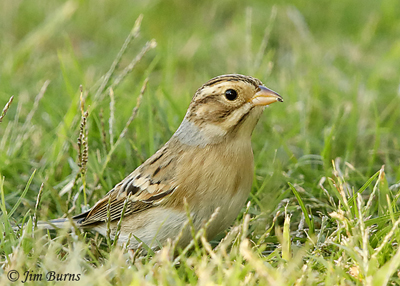
This bird in fresh, definitive basic plumage, noted by no less a sparrow authority than James D. Rising as “perhaps our most beautiful sparrow,” was foraging on the ground in plain sight, its egregious neglect allegedly caused by the presence of a scruffy, molting, and flighty hatch year Black-throated Blue Warbler, its namesake color appearing no more than dingy slate gray in the deep shade of the mesquite understory.
This issue came to the family’s attention a week after their envoy to Roadrunner Park, a juvenile Clay-colored Sparrow, reported to them that only a few of your people visited, never more than one or two at a time, and most were having trouble recognizing it in a flock of plain, brown, streaky finches. This scenario played out despite the sparrow’s clean, distinctive face pattern, the gorgeous gray collar, and the beautiful buffy wash across its breast, unstreaked because it had already lost its juvenile plumage.
A further affront to the family took place the following week at the Canoa Ranch when their traveling ambassador, a Vesper Sparrow, was initially noted by an experienced member of your tribe as a Savannah Sparrow. This indefensible case of identification malfeasance was not rectified until said observer finally noticed the distinctive and well-known rufous lesser wing coverts of the Vesper on the computer screen well after the fact.
The Sparrow family has documentation that they sent just as many of their agents to visit your venues this past autumn as the apparently more highly regarded, eagerly sought, and highly attended eastern clan of the Warbler family. The salient issues here are twofold. The Sparrow family representatives have been regular western birds that should be much more commonly expected and recognized than those sent by the Warbler family and, unlike those transient vagrants, the sparrows will stay the winter.
In this category I would cite the Grasshopper Sparrow at the Glendale Recharge Basin, the Fox Sparrow at Ash Canyon Bird Sanctuary, the Sagebrush Sparrow at Canoa Ranch, and the white-striped White-throated Sparrow at Boyce Thompson Arboretum. This list does not even include but acknowledges the many members of the junco branch of the family, the true “snowbirds,” that your people seem routinely to take for granted this time of year.
The Sparrow family questions why the aforementioned emissaries are not more highly sought, let alone more readily recognized and widely celebrated when seen. The family does not dispute being called the ultimate identification challenge, but they contend that is all the more reason to seek them out. Nor do they mind their beauty being called “subtle,” but they’ve had it up to here being seen as cosmetically challenged, and they’d like to be appreciated by your people. The family has herewith authorized me, in lieu of damages, to declare 2021 The Year of the Sparrow and announce they are sending more representatives to your hotspots to see that your tribe does not forego the opportunity to seek out their subtle but beautiful plumage. In closing, be informed that I will be closely monitoring this situation through the end of May.